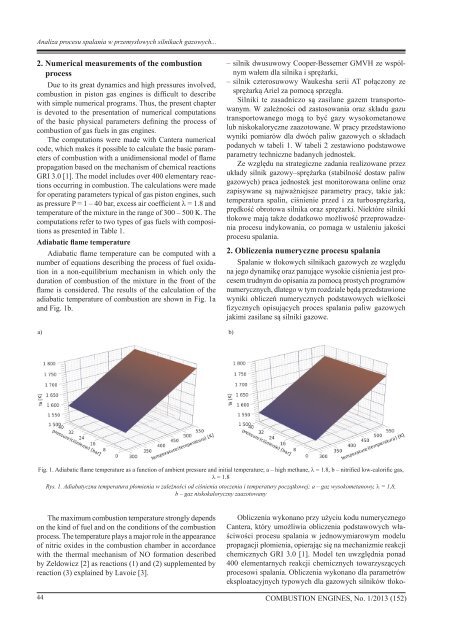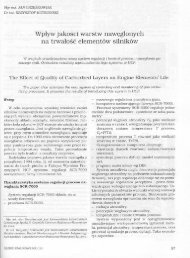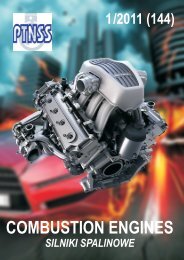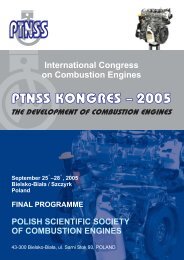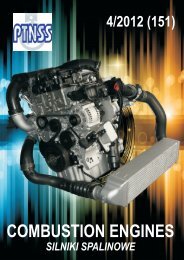Create successful ePaper yourself
Turn your PDF publications into a flip-book with our unique Google optimized e-Paper software.
Analiza procesu spalania w przemysłowych silnikach gazowych...<br />
2. Numerical measurements of the combustion<br />
process<br />
Due to its great dynamics and high pressures involved,<br />
combustion in piston gas engines is difficult to describe<br />
with simple numerical programs. Thus, the present chapter<br />
is devoted to the presentation of numerical computations<br />
of the basic physical parameters defining the process of<br />
combustion of gas fuels in gas engines.<br />
The computations were made with Cantera numerical<br />
code, which makes it possible to calculate the basic parameters<br />
of combustion with a unidimensional model of flame<br />
propagation based on the mechanism of chemical reactions<br />
GRI 3.0 [1]. The model includes over 400 elementary reactions<br />
occurring in combustion. The calculations were made<br />
for operating parameters typical of gas piston engines, such<br />
as pressure P = 1 – 40 bar, excess air coefficient l = 1.8 and<br />
temperature of the mixture in the range of 300 – 500 K. The<br />
computations refer to two types of gas fuels with compositions<br />
as presented in Table 1.<br />
Adiabatic flame temperature<br />
Adiabatic flame temperature can be computed with a<br />
number of equations describing the process of fuel oxidation<br />
in a non-equilibrium mechanism in which only the<br />
duration of combustion of the mixture in the front of the<br />
flame is considered. The results of the calculation of the<br />
adiabatic temperature of combustion are shown in Fig. 1a<br />
and Fig. 1b.<br />
– silnik dwusuwowy Cooper-Bessemer GMVH ze wspólnym<br />
wałem dla silnika i sprężarki,<br />
– silnik czterosuwowy Waukesha serii AT połączony ze<br />
sprężarką Ariel za pomocą sprzęgła.<br />
Silniki te zasadniczo są zasilane gazem transportowanym.<br />
W zależności od zastosowania oraz składu gazu<br />
transportowanego mogą to być gazy wysokometanowe<br />
lub niskokaloryczne zaazotowane. W pracy przedstawiono<br />
wyniki pomiarów dla dwóch paliw gazowych o składach<br />
podanych w tabeli 1. W tabeli 2 zestawiono podstawowe<br />
parametry techniczne badanych jednostek.<br />
Ze względu na strategiczne zadania realizowane przez<br />
układy silnik gazowy–sprężarka (stabilność dostaw paliw<br />
gazowych) praca jednostek jest monitorowana online oraz<br />
zapisywane są najważniejsze parametry pracy, takie jak:<br />
temperatura spalin, ciśnienie przed i za turbosprężarką,<br />
prędkość obrotowa silnika oraz sprężarki. Niektóre silniki<br />
tłokowe mają także dodatkowo możliwość przeprowadzenia<br />
procesu indykowania, co pomaga w ustaleniu jakości<br />
procesu spalania.<br />
2. Obliczenia numeryczne procesu spalania<br />
Spalanie w tłokowych silnikach gazowych ze względu<br />
na jego dynamikę oraz panujące wysokie ciśnienia jest procesem<br />
trudnym do opisania za pomocą prostych programów<br />
numerycznych, dlatego w tym rozdziale będą przedstawione<br />
wyniki obliczeń numerycznych podstawowych wielkości<br />
fizycznych opisujących proces spalania paliw gazowych<br />
jakimi zasilane są silniki gazowe.<br />
a) b)<br />
Fig. 1. Adiabatic flame temperature as a function of ambient pressure and initial temperature; a – high methane, l = 1.8, b – nitrified low-calorific gas,<br />
l = 1.8<br />
Rys. 1. Adiabatyczna temperatura płomienia w zależności od ciśnienia otoczenia i temperatury początkowej; a – gaz wysokometanowy, l = 1,8,<br />
b – gaz niskokaloryczny zaazotowany<br />
The maximum combustion temperature strongly depends<br />
on the kind of fuel and on the conditions of the combustion<br />
process. The temperature plays a major role in the appearance<br />
of nitric oxides in the combustion chamber in accordance<br />
with the thermal mechanism of NO formation described<br />
by Zeldowicz [2] as reactions (1) and (2) supplemented by<br />
reaction (3) explained by Lavoie [3].<br />
Obliczenia wykonano przy użyciu kodu numerycznego<br />
Cantera, który umożliwia obliczenia podstawowych właściwości<br />
procesu spalania w jednowymiarowym modelu<br />
propagacji płomienia, opierając się na mechanizmie reakcji<br />
chemicznych GRI 3.0 [1]. Model ten uwzględnia ponad<br />
400 elementarnych reakcji chemicznych towarzyszących<br />
procesowi spalania. Obliczenia wykonano dla parametrów<br />
eksploatacyjnych typowych dla gazowych silników tłoko-<br />
44 <strong>COMBUSTION</strong> <strong>ENGINES</strong>, No. 1/2013 (152)


